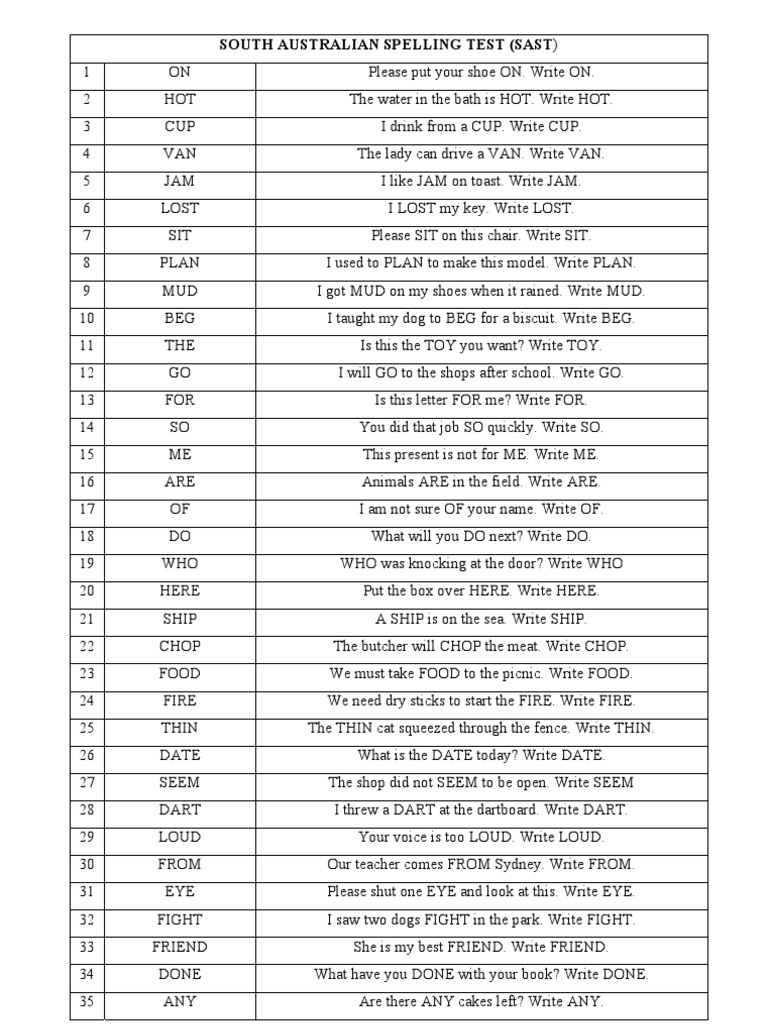
South Australian Spelling Test Templates
Supportive Research. Aukerman, in his book, Approaches To Beginning Reading, describes Spalding as a total language arts program because it 'is an approach to learning the phonetic base of the language through listening, seeing, speaking, writing, spelling, and reading' (p.536).
We've selected just 30 sample words from grades 1-9 and compiled them here. Igru princessi dvorec dlya zolushki youtube. You may use this list to get a rough idea of the proper level of words for your child to study. How to Use These Printable Spelling Lists 1) Quiz your child, orally or written, over the 30 words at the grade level you think might be at his current skill level. 2) If he spells 26 words or more correctly, he probably has a good grasp of most of the words in our larger lists at that level. You could quickly review the hardest words from that grade before moving on to the next level.
3) If he spells 20-25 words correctly, you should stay at that grade level and give your child plenty of practice in mastering those words. 4) If he spells less than 20 words correctly, you should back up to the previous grade and be sure he can correctly spell at least 26 of those words before trying to do anything more difficult.
There are a number of literacy diagnostic tests that may be of use when you are starting to assess children needing literacy support. South Australian Spelling Test This test will give a spelling age of the children in your class. It is a good idea to administer the test at the beginning, middle and end of the school year. The test will give you an age range from 6-15 years. You will be able to see the spelling ability of each student. The data collected from the South Australian Spelling test can be used when teacher’s design lessons, support programs, reporting as well as grouping students accordingly. I would advise teachers to collate data in an excel spreadsheet.
You can have the name of the child, date of birth, age then spelling age according to the South Australian Spelling Test markers guide. Data collated can then be turned into graphs and further analysis made. Waddington Diagnostic Reading Test The Waddington is a clearly set out diagnostic test presented in an A4 size book within which are the photocopiable tests. The front page accommodates student, school and assessment details. A small ‘sample’ test section is provided to assist with explanation of the test tasks. The tests begin very simply with basic picture/sound cues then gradually become more difficult and complex. Support students can do Test 1 in the second term and Test 2 in the fourth term.
It easy to follow and are not daunted by it nor do they find it threatening. The Waddington tests have clear understood and guidelines for teachers giving the test. The test is not too long (30 minutes) and easy to mark, yet valid when it comes to assessing the literacy of the students. Waddington states, (2000)“It is a very useful and efficient screening device,” I agree with Waddington (1988) in that the ‘true value of this test lies in the diagnostic information which can be extracted for programming purposes. Middle Years Ability Test (MYAT) Range Middle Years students: last two years of primary, first two years of secondary. Purpose To provide a measure of general ability.
Administration 45 minutes — group The Middle Years Ability Test (MYAT) is a test of general ability designed to assist teachers in their assessment of students aged 10–15 years. MYAT is a completely revised and updated edition of the ACER Intermediate Tests F and G. As well as verbal and numerical reasoning items in the tradition of the ACER Intermediate Tests, MYAT includes non-verbal (or abstract) reasoning items, giving a more complete picture of students’ general ability. Key Features: • Excellent group test of general ability • Contains literacy, numeracy and non-verbal items in two parallel forms • Up-to-date Australian norms • Can be used to help in identification of gifted and talented students • Machine scored through ACER’s test scoring service or handscored • The MYAT Report provides an overall ability score and a profile of the student’s performance in each of the three sub-scale areas. • Assessment Content: 75 multiple-choice items: • Numeracy – 25 items which provide information about the extent to which a student can exercise basic numeracy skills, is a discriminating and accurate user of mathematical methods, and can reason, solve and construct meaning from number problems.  • Literacy – 25 items which provide information about the extent to which a student can exercise basic literacy skills, is a discriminating and accurate word user, and can reason and construct meaning from text.
• Literacy – 25 items which provide information about the extent to which a student can exercise basic literacy skills, is a discriminating and accurate word user, and can reason and construct meaning from text.